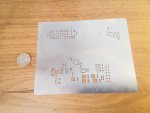Runs With Scissors
Well-known member
Equipment
L2501 TLB , Grappel, Brush Hog, Box Blade, Ballast box, Forks, Tiller, PH digger
I have two of the S190s, and the other shown is a shop-made one of similar size.
I find them to be perfect size; if you need them taller, just throw a chunk of stock or step blocks under them.
Or, if you're a purist, making extension blocks of any height is easy.
(note aluminum extension in my 2nd pic)
Stay away from cheapies, they tend to have coarse threads with sloppy fits, making adjustment difficult. (ask me how I know)
The finer the pitch, the easier the adjustment.
The ball joint and different shaped anvils are pretty handy for varied setups.
Put an indicator on the part if you need precision, makes it easier to see if it is supported or deflected upward.
I had a beautiful pair of tiny ones, 1" tall, 10-32 thread, case hardened finish, if I remember correctly, but I never used them in 25+ years of owning them, so I sold them to a collector for $75.
Thanks Bill,
I just ordered a complete Starrett 191 set. (1 jack with all the adaptors)
Should be here in a day or so.
Just like any/most other tools I have; You may not need it today, but when you gotta have it, it’s nice to be able to walk over and just grab it.
Hopefully one day, I will have the time to make myself one as well, but for now, it’s “The Big A” to the rescue…..


